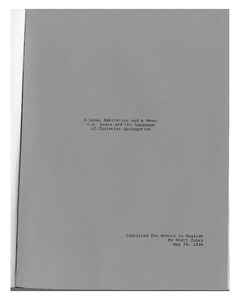| dc.rights.license | In Copyright | en_US |
| dc.creator | Cohrs, Andrew Brett | |
| dc.date.accessioned | 2023-10-20T15:49:29Z | |
| dc.date.available | 2023-10-20T15:49:29Z | |
| dc.date.created | 1994 | |
| dc.identifier | WLURG038_Cohrs_thesis_1994 | |
| dc.identifier.uri | https://dspace.wlu.edu/handle/11021/36271 | |
| dc.description.abstract | C.S. Lewis is a source of intrigue for many twentieth century readers. His audience consists of Christian lay-persons, students of English literature, scholars, clergy, and others. For many of
us, C.S. Lewis' popularity stems from his children's stories; the Chronicles of Narnia. In addition to that famed set of books, Lewis is known for his Space Trilogy and his appeal to evangelical
Christians because of his own dramatic conversion and his apologetics, which have been an inspiration to many. But there are many Christian apologists, just as there are many science fiction and children's literature writers. What is it about Lewis that makes him so popular? No doubt his ability to convey religious ideas with clarity is a major reason for his popularity. Lewis relies heavily on metaphorical argument as a valid means for relating truth, and this metaphorical and analogical argument makes his works accessible to the average reader. In the last decade or so,
linguistic theorists have come to view the use of metaphor as deeply involved not only in the way we write, but also in the way we think. After looking at theoretical background in the area of
linguistics, we will examine Lewis' use of metaphor. This paper makes a case that Lewis consciously and confidently relies on metaphor and analogy as necessary tools for treating questions of religion. First, the paper will examine George Lakoff and Mark Johnson's theory of metaphor as laid out in Metaphors We Live By; this theory illuminates Lewis' metaphorical style. Then, we will examine Lewis' literary criticism. His criticism reveals that metaphor is indeed one of his fundamental interests. Finally, we will turn to Lewis' nonfiction and fiction, devoting a chapter to both Mere Christianity and Till We Have Faces, in order to show the centrality of metaphor and analogy to Lewis' arguments concerning religion. The examination of Mere Christianity will demonstrate how Lewis uses metaphorical argument while our analysis of Till We Have Faces answers the question of why metaphorical argument can be necessary in understanding religious truth. By the end, we will have discovered the ways in which Lewis uses metaphor and gained insight on why his style is so effective in explaining religious concepts. [From Introduction] | en_US |
| dc.format.extent | 64 pages | en_US |
| dc.language.iso | en_US | en_US |
| dc.rights | This material is made available for use in research, teaching, and private study, pursuant to U.S. Copyright law. The user assumes full responsibility for any use of the materials, including but not limited to, infringement of copyright and publication rights of reproduced materials. Any materials used should be fully credited with the source. | en_US |
| dc.rights.uri | http://rightsstatements.org/vocab/InC/1.0/ | en_US |
| dc.subject.other | Washington and Lee University -- Honors in English | en_US |
| dc.title | A Local Habitation and a Name: C. S. Lewis and the Language of Christian Apologetics | en_US |
| dc.type | Text | en_US |
| dcterms.isPartOf | WLURG038 - Student Papers | en_US |
| dc.rights.holder | Cohrs, Andrew Brett | en_US |
| dc.subject.fast | Lewis, C. S. (Clive Staples), 1898-1963 | en_US |
| dc.subject.fast | English literature -- Apologetic writings | en_US |
| dc.subject.fast | Christian literature | en_US |
| local.department | English | en_US |
